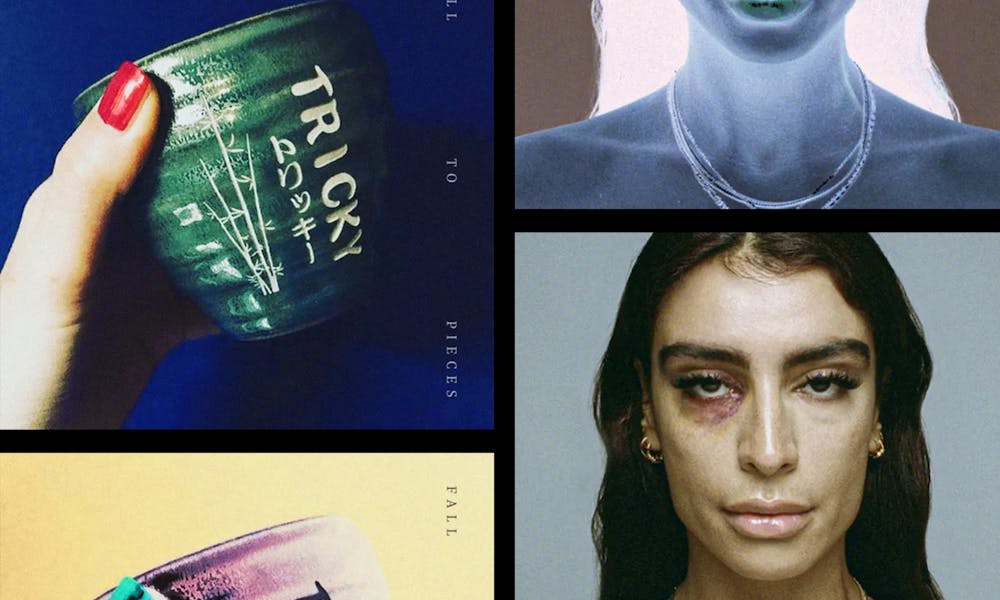Close your eyes. Imagine, if you can, what the '90s were like. Not the literal day–to–day hustle and bustle, but the general mood. It's the middle of the night, and you're walking down a street. Sewer fumes obscure your vision, but it doesn't matter, because you haven't decided where you're walking to yet. Your baggy jeans and Nirvana tee are fashionably grimy, covered in tiny circular burns and beer stains. You take a long, last drag of your dying cigarette before stamping out the embers, extinguishing the final light of the dark alley you just turned down. Your headphones drown out the incessant rumblings of city life: ever so slowly, the hiss and crackle of vinyl pops fade in, washing out your ears like auditory smoke. "Give me a reason to love you," the lead singer croons over a wailing guitar solo.
In the '90s, one sound reigned supreme: the powerfully dark, noir–influenced vibes of trip–hop. I was born in 1999—I missed out on the actual experiences of the '90s—but there's something about trip–hop that allows us to tap into the zeitgeist of decades past in a way that a lot of genres can't do. The music is foreign yet instantly familiar; it's dingy, minimal, slow, gritty, and ever so sexual, yet it exists solely in a different era. Trip–hop sounds like an after–hours event at an after–hours nightclub, when all of the uppers have worn off and the intoxicating aura of lethargic exhaustion clings to the sweat–soaked floors.
Trip–hop started and ended in Bristol, England. In the early 1980s, a sound system, the Wild Bunch, started making waves in the Bristol underground scene. By fusing together a massive range of genres (especially old punk, R&B, and reggae records) to create tired, washed–out beats, they developed an entirely new style of music: trip–hop. Key members of the Wild Bunch included—among many others—Tricky and Robert Del Naja.
Del Naja, Tricky, and a few other members of the collective eventually formed Massive Attack. Their first album, Blue Lines, came out in 1991 and essentially laid the foundations of the genre in the mainstream. Their most notable album, though, is 1998's Mezzanine. They've released a few other records since then (their last one, Heligoland, came in 2010), but the decline of Massive Attack more or less marked the decline of trip–hop.
Tricky left Massive Attack at some point after its inception, and began releasing his own solo material. His 1995 album, Maxinquaye, was a landmark release for trip–hop. The music on Maxinquaye ranges from industrial rock remixes of Public Enemy tracks to chill–inducing, melodramatic displays of vocal acrobatics. Trip–hop sounds like a lot of things, and Maxinquaye was a reminder that above all else, trip–hop was as secretive and sensual as a midnight hook–up.
The third notable trip–hop pioneer is Portishead. Though they don't have any formal ties to the Wild Bunch, their 1994 album, Dummy, is widely regarded as the definitive trip–hop album, firmly cementing the collection of sounds and influences into a coherent genre. They've released just two other albums since then—Portishead in 1997, and Third in 2008—but are more or less inactive now.
Tricky, then, is the only member of this unholy trinity of trip–hop troublemakers who still consistently releases music. To be frank, his new stuff isn't good. It's still trip–hop, sure, but it hasn't translated well to 2020. His latest album, Fall to Pieces, makes for an especially embarrassing listen. How could one of the progenitors of the style misunderstand it on such a fundamental level, only three decades later? For Tricky, the minimal aesthetics of the genre have given way to unfinished beats, boring melodies, uninspired samples, and lifeless vocals. It seems he's mistaking whispered platitudes of edginess for genuine gloominess and slow, boring drums for feelings of cultural malaise. The one track worth listening to, "Running Off," still offers nothing of note other than a slightly interesting beat.
That's it, then. Trip–hop is officially dead; its creators have either abandoned the sound, given up, or can no longer inspire similar feelings of genuine dread that carried the music through the '90s. There haven't been any significant revivals like other genres have seen, and none of the smaller acts that filled out the Massive Attack/Tricky/Portishead trinity gained large enough followings to survive. It will forever be a relic of the past, a cultural touchstone for an era gone by.
The one artist still maintaining the dark, grimy aesthetics of the genre, while releasing incredibly malaise music, is Sevdaliza. Iranian–born and Amsterdam–residing, Sevdaliza released her sophomore album, Shabrang, the same day Tricky's Fall to Pieces came out. Where Tricky's effort was boring and uninspired, Sevdaliza's album is just as experimental as it is an homage to trip–hop's heyday.
"Rhode," for example, draws directly from Portishead's Third, culminating in a disturbing instrumental break that carries the demented fury of a circular saw slicing through bone. Other songs on Shabrang reference trip–hop in a similarly direct way: "All Rivers At Once" is a slow–burning, moody guitar jam; "Lamp Lady" uses a dusty, downtempo drum sample; "No Way," "Habibi," and "Gole Bi Goldoon" showcase Sevdaliza's versatile soprano vocals in a way that rings eerily similar to Portishead's Beth Gibbons.
Discussing trip–hop in the present tense is a futile task. The genre peaked decades ago, and despite notable newcomers like Sevdaliza still showcasing different, innovative sounds, trip–hop will forever remain a window into the sights and sounds of the 90s. Let it die a dignified death: we can always spin our favorite records again, but we can't as easily repair a tarnished legacy.







